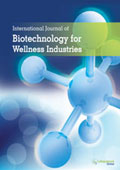ijbwi
Abstract : The Influence of Electrospinning Parameters and Drug Loading on Polyhydroxyalkanoate (PHA) Nanofibers for Drug Delivery
|
|
Abstract: The impact of polymer concentration and drug loading on nanofiber morphology and diameter were investigated during electrospinning of polyhydroxyalkanoate nanofibrous films. Low molecular weight poly(3-hydroxybutyrate-co-4-hydroxybutyrate) [P(3HB-co-95 mol% 4HB)] required a 5-fold higher solution concentration than high molecular weight poly(3-hydroxybutyrate) [P(3HB)] to produce bead-free nanofibers. Loading the films with paclitaxel increased the initial polymer solution viscosity allowing larger diameter nanofibers to form. Furthermore, paclitaxel added at 1% (w/w) into 8 % (w/v) P(3HB-co-95 mol% 4HB) solution eliminated the formation of beads seen in solutions without the drug, at the same initial polymer solution concentration. In preliminary drug release studies, nanofiber mats consisting of large-diameter nanofibers with high drug loading released paclitaxel at a faster rate due to larger pore sizes. This was a consequence of the random packing of larger diameter nanofibers. However, the release pattern of nanofibers with low drug loading was much more consistent and controlled. Lastly, we have shown the potential applications of P(3HB-co-4HB) drug loaded nanofibers in the development of biocompatible drug eluting stents by directly coating a metal stent with a homogeneous layer of electrospun polymer. Keywords: polyhydroxyalkanoate, electrospinning, nanofibers, drug loading, biocompatibility.Download Full Article |
Abstract : Enrichment of Mung Bean with L-DOPA, GABA, Essential Amino Acids via Controlled Biofermentation Strategy
|
|
Abstract: L-DOPA (L-3,4-dihydroxyphenylalanine) the precursor of neurotransmitter dopamine is used in the management of Parkinson disease and effective in controlling diabetic state. Gamma-aminobutyric acid (GABA), a non-protein amino acid is known to have many pharmacological functions and plays a major role in inhibiting neurotransmitter in brain. Whereas essential amino acids can’t synthesize in human body and it must be taken from foods to maintain good immune function. This study aims to evaluate the enrichment of mung bean with L-DOPA, GABA and essential amino acids via controlled solid state fermentation using Rhizopus strain 5351. Fermentation was carried out for a duration up to 48 h at 30 °C and the samples were analyzed at certain time intervals. The concentration of glucosamine and β-glucosidase, which indicated the growth of fungal was noted low at the early growth stage (0 to 10 h), but it was observing increased linearly within 18 to 48 h growth periods. The L-DOPA was produced after 10 h fermentation time (0.008 g/100 g dry weight, DW) and the highest yield of L-DOPA content (0.07 g/100 g DW) was attained at the fermentation time of 28 h. However, the concentration of L-DOPA was noted decreased after that. The protease activity, free and essential amino acids content also showed a drastic increment within the fermentation period of 10 to 38 h. The highest content of free and essential amino acids (FAAs and EAAs) and the protease activity of fermented mung bean were exhibited at 38 h incubation time, which were 3.74 g/100 g DW, 1.43 g/100 g DW and 18.4 U/g dry weight, respectively. The GABA content of fermented mung bean was found low (0.019 - 0.021 g/100 g DW) at early incubation time (0-10 h), however, it showed a drastic increment in the fermented mung bean after 18 h (0.132 g/100 g DW) and continuously increased until 38 h (0.198 g/100 g DW). This study showed the potential of solid state fermentation as a good strategy to enrich the fermented mung bean with L-DOPA, GABA and other beneficial bioactive compounds which play an important role to maintain good health as it helps to enhance our immune system and regulating neurotransmitter function. Keywords: L-DOPA, GABA, Mung Bean, Protease, Solid State Fermentation.Download Full Article |
Abstract : The Effect of Bacteria on Seed Germination in Sorghum and Rape Under Cadmium and Petroleum Conditions
|
|
Abstract: A large amount of oil hydrocarbons and heavy metals have been discharged into the environment and caused soil polluted. Petroleum and cadmium in soil accumulated in crops and lead to threaten human healthy through the food chain. In this experiment, seeds of sorghum and rape were germinated in deferent concentrations of petroleum and cadmium, and the effect of Peptococcus activus sp. SH3-3-9 on the germination was studied. The results showed that petroleum and cadmium inhibited seeds germination, and the effects were stronger as their concentrations increased. Peptococcus activus sp.SH3-3-9 had the role of enhancing seed germination, which indicates it has high potential in plant-microbial remediation of petroleum and cadmium in soil. Keywords: Bacteria, cadmium, petroleum, sorghum, rape.Download Full Article |
Abstract : The Anti-Microbial Properties of Triticum aestivum (Wheat Grass) Extract
|
|
Abstract: Wheat grass, one of the members of Poaceae family, has been considered for very efficient therapeutic drugs. Current study was aimed at evaluation of antimicrobial properties of wheat grass extracts. The 7th., 14th., and 21st. day wheat grass extracts of five different solvents (water, ethanol, methanol, ethyl acetate and hexane) were assayed for antimicrobial activity using turbidity tests. All these extracts showed antibacterial activity against seven food borne pathogens. Amongst them hexane extracts from 7th day old wheat grass showed maximum antibacterial activity especially more against Yersinia enterocolitica and Listeria monocytogenes. The HPLC purified extract was observed to create pores on the cell wall of the bacterial cells as observed under Scanning Electron Microscope and also influenced flattening and shrinkage of bacterial cells indicating probable effect on the membrane of the pathogenic bacteria. Keywords: Triticum aestivum, Antimicrobial activity, Solvent extraction, Bioactive molecule, SEM.Download Full Article |























